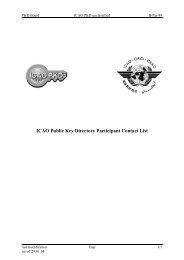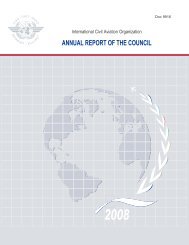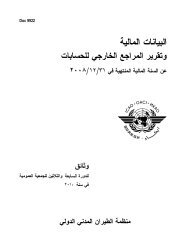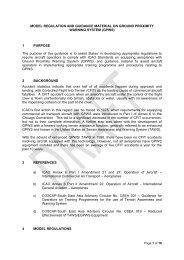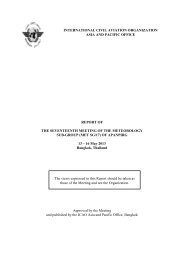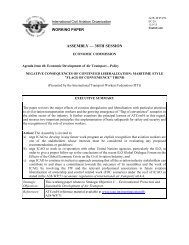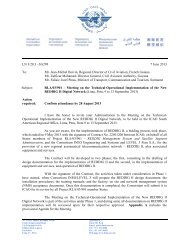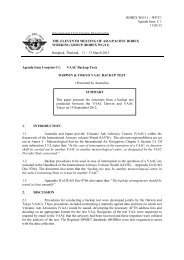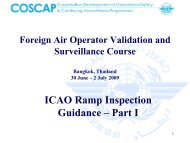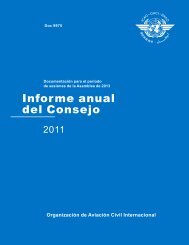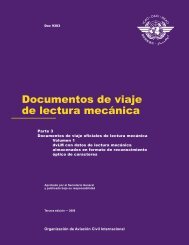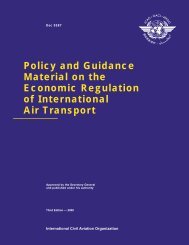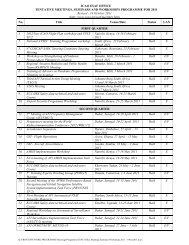Create successful ePaper yourself
Turn your PDF publications into a flip-book with our unique Google optimized e-Paper software.
Doc 9851<br />
Docum<strong>en</strong>tation for the session<br />
of the Assembly in 2007<br />
Annual Report<br />
of the Council<br />
2004<br />
International Civil Aviation Organization
Published in separate English, Arabic, Chinese, Fr<strong>en</strong>ch, Russian and Spanish editions by the International Civil Aviation<br />
Organization. All correspond<strong>en</strong>ce, except orders and subscriptions, should be addressed to the Secretary G<strong>en</strong>eral.<br />
Orders should be s<strong>en</strong>t to one of the following addresses, together with the appropriate remittance (by bank draft, cheque or money order)<br />
in U.S. dollars or the curr<strong>en</strong>cy of the country in which the order is placed. Credit card orders (American Express, MasterCard and Visa)<br />
are accepted at <strong>ICAO</strong> Headquarters.<br />
International Civil Aviation Organization. Att<strong>en</strong>tion: Docum<strong>en</strong>t Sales Unit, 999 University Street, Montréal, Quebec, Canada H3C 5H7<br />
Telephone: +1 (514) 954-8022; Facsimile: +1 (514) 954-6769; Sitatex: YULCAYA; E-mail: sales@icao.int;<br />
World Wide Web: http://www.icao.int<br />
China. Glory Master International Limited, Room 434B, Hongsh<strong>en</strong> Trade C<strong>en</strong>tre, 428 Dong Fang Road, Pudong, Shanghai 200120<br />
Telephone: +86 137 0177 4638; Facsimile: +86 21 5888 1629; E-mail: glorymaster@online.sh.cn<br />
Egypt. <strong>ICAO</strong> Regional Director, Middle East Office, Egyptian Civil Aviation Complex, Cairo Airport Road, Heliopolis, Cairo 11776<br />
Telephone: +20 (2) 267 4840; Facsimile: +20 (2) 267 4843; Sitatex: CAICAYA; E-mail: icao@idsc.net.eg<br />
France. Directeur régional de l’OACI, Bureau Europe et Atlantique Nord, 3 bis, villa Émile-Bergerat, 92522 Neuilly-sur-Seine (Cedex)<br />
Téléphone: +33 (1) 46 41 85 85; Fax: +33 (1) 46 41 85 00; Sitatex: PAREUYA; Courriel: icaoeurnat@paris.icao.int<br />
Germany. UNO-Verlag GmbH, Am Hofgart<strong>en</strong> 10, D-53113 Bonn / Telephone: +49 (0) 2 28-9 49 0 20; Facsimile: +49 (0) 2 28-9 49 02 22;<br />
E-mail: info@uno-verlag.de; World Wide Web: http://www.uno-verlag.de<br />
India. Oxford Book and Stationery Co., Scindia House, New Delhi 110001 or 17 Park Street, Calcutta 700016<br />
Telephone: +91 (11) 331-5896; Facsimile: +91 (11) 51514284<br />
India. Sterling Book House – SBH, 181, Dr. D. N. Road, Fort, Bombay 400001<br />
Telephone: +91 (22) 2261 2521, 2265 9599; Facsimile: +91 (22) 2262 3551; E-mail: sbh@vsnl.com<br />
Japan. Japan Civil Aviation Promotion Foundation, 15-12, 1-chome, Toranomon, Minato-Ku, Tokyo<br />
Telephone: +81 (3) 3503-2686; Facsimile: +81 (3) 3503-2689<br />
K<strong>en</strong>ya. <strong>ICAO</strong> Regional Director, Eastern and Southern African Office, United Nations Accommodation, P.O. Box 46294, Nairobi<br />
Telephone: +254 (20) 622 395; Facsimile: +254 (20) 623 028; Sitatex: NBOCAYA; E-mail: icao@icao.unon.org<br />
Mexico. Director Regional de la OACI, Oficina Norteamérica, C<strong>en</strong>troamérica y Caribe, Av. Presid<strong>en</strong>te Masaryk No. 29, 3 er Piso,<br />
Col. Chapultepec Morales, C.P. 11570, México D.F. / Teléfono: +52 (55) 52 50 32 11; Facsímile: +52 (55) 52 03 27 57;<br />
Correo-e: icao_nacc@mexico.icao.int<br />
Nigeria. Landover Company, P.O. Box 3165, Ikeja, Lagos<br />
Telephone: +234 (1) 4979780; Facsimile: +234 (1) 4979788; Sitatex: LOSLORK; E-mail: aviation@landovercompany.com<br />
Peru. Director Regional de la OACI, Oficina Sudamérica, Apartado 4127, Lima 100<br />
Teléfono: +51 (1) 575 1646; Facsímile: +51 (1) 575 0974; Sitatex: LIMCAYA; Correo-e: mail@lima.icao.int<br />
Russian Federation. Aviaizdat, 48, Ivan Franko Street, Moscow 121351 / Telephone: +7 (095) 417-0405; Facsimile: +7 (095) 417-0254<br />
S<strong>en</strong>egal. Directeur régional de l’OACI, Bureau Afrique occid<strong>en</strong>tale et c<strong>en</strong>trale, Boîte postale 2356, Dakar<br />
Téléphone: +221 839 9393; Fax: +221 823 6926; Sitatex: DKRCAYA; Courriel: icaodkr@icao.sn<br />
Slovakia. Air Traffic Services of the Slovak Republic, Letové prevádzkové sluzby Slov<strong>en</strong>skej Republiky, State Enterprise,<br />
Letisko M.R. Stefánika, 823 07 Bratislava 21 / Telephone: +421 (7) 4857 1111; Facsimile: +421 (7) 4857 2105<br />
South Africa. Avex Air Training (Pty) Ltd., Private Bag X102, Halfway House, 1685, Johannesburg<br />
Telephone: +27 (11) 315-0003/4; Facsimile: +27 (11) 805-3649; E-mail: avex@iafrica.com<br />
Spain. A.E.N.A. — Aeropuertos Españoles y Navegación Aérea, Calle Juan Ignacio Luca de T<strong>en</strong>a, 14, Planta Tercera, Despacho 3. 11,<br />
28027 Madrid / Teléfono: +34 (91) 321-3148; Facsímile: +34 (91) 321-3157; Correo-e: sscc.v<strong>en</strong>tasoaci@a<strong>en</strong>a.es<br />
Switzerland. Adeco-Editions van Dierm<strong>en</strong>, Attn: Mr. Martin Richard Van Dierm<strong>en</strong>, Chemin du Lacuez 41, CH-1807 Blonay<br />
Telephone: +41 021 943 2673; Facsimile: +41 021 943 3605; E-mail: mvandierm<strong>en</strong>@adeco.org<br />
Thailand. <strong>ICAO</strong> Regional Director, Asia and Pacific Office, P.O. Box 11, Samyaek Ladprao, Bangkok 10901<br />
Telephone: +66 (2) 537 8189; Facsimile: +66 (2) 537 8199; Sitatex: BKKCAYA; E-mail: icao_apac@bangkok.icao.int<br />
United Kingdom. Airplan Flight Equipm<strong>en</strong>t Ltd. (AFE), 1a Ringway Trading Estate, Shadowmoss Road, Manchester M22 5LH<br />
Telephone: +44 161 499 0023; Facsimile: +44 161 499 0298; E-mail: <strong>en</strong>quiries@afeonline.com; World Wide Web: http://www.afeonline.com<br />
Catalogue of <strong>ICAO</strong> Publications<br />
and Audio-visual Training Aids<br />
Issued annually, the Catalogue lists all publications and audio-visual training aids<br />
curr<strong>en</strong>tly available. Monthly supplem<strong>en</strong>ts announce new publications and audio-visual<br />
training aids, am<strong>en</strong>dm<strong>en</strong>ts, supplem<strong>en</strong>ts, reprints, etc.<br />
Available free from the Docum<strong>en</strong>t Sales Unit, <strong>ICAO</strong>.<br />
2/05
TO THE ASSEMBLY<br />
OF THE<br />
INTERNATIONAL CIVIL AVIATION ORGANIZATION<br />
I have the honour to transmit, at the direction of the Council, its Report for the year 2004 prepared<br />
in compliance with Article 54(a) of the Conv<strong>en</strong>tion on International Civil Aviation. It constitutes<br />
docum<strong>en</strong>tation for the next ordinary Session of the Assembly, which will be conv<strong>en</strong>ed in 2007, but it<br />
is being circulated to Contracting States now for their information. It will also be s<strong>en</strong>t to the<br />
Economic and Social Council of the United Nations in pursuance of Article VI, paragraph 2 (a) of<br />
the Agreem<strong>en</strong>t betwe<strong>en</strong> the United Nations and <strong>ICAO</strong>.<br />
The Report was prepared by the Secretariat and circulated in draft form to the<br />
Repres<strong>en</strong>tatives of Council Member States for their suggestions. The Council, as a body, did not<br />
formally examine or adopt it but, as in the past, delegated to its Presid<strong>en</strong>t authority to approve the<br />
final text after considering all the suggestions received.<br />
___________________<br />
Sixty years ago, on 7 December 1944, <strong>ICAO</strong> was created with the signing of the Conv<strong>en</strong>tion on<br />
International Civil Aviation. Since that time, it has be<strong>en</strong> an effective forum for global cooperation<br />
among its Contracting States and members of the world aviation community in <strong>en</strong>hancing the safety,<br />
security and effici<strong>en</strong>cy of our skies and airspace around airports.<br />
From a fledgling industry to an important player in the world economy, air transport is<br />
today a vital part of our daily lives. It makes it possible for us as tourists or business people to safely<br />
and quickly reach practically any place on the face of the earth and provides us with many of the<br />
goods and services that we use everyday in homes and offices.<br />
As we <strong>en</strong>ter a new chapter in the Organization’s history, we confid<strong>en</strong>tly set our sights on a<br />
chall<strong>en</strong>ging future, determined to continue striving for optimum safety and security; the continued<br />
progressive, worldwide liberalization of air transport; a globally interoperable, harmonized and<br />
seamless air traffic managem<strong>en</strong>t system; maximum compatibility betwe<strong>en</strong> the safe and orderly<br />
developm<strong>en</strong>t of civil aviation and the quality of the <strong>en</strong>vironm<strong>en</strong>t; and the further developm<strong>en</strong>t of a<br />
unified, global legal framework.<br />
Yes, the direction has be<strong>en</strong> set. Our goals are clear. Global cooperation remains the key to<br />
meeting all of these chall<strong>en</strong>ges, as it has guided us for the past 60 years.<br />
Assad Kotaite<br />
Presid<strong>en</strong>t of the Council
TABLE OF CONTENTS<br />
Glossary ................................................................................................................................................ vii<br />
Chapter 1. Facts about <strong>ICAO</strong> ........................................................................................................... 1<br />
What it is ........................................................................................................................................... 1<br />
What it does ...................................................................................................................................... 1<br />
How it works...................................................................................................................................... 2<br />
Strategic objectives........................................................................................................................... 3<br />
Future directions ............................................................................................................................... 3<br />
<strong>ICAO</strong> publications ............................................................................................................................. 5<br />
The <strong>ICAO</strong> website at www.icao.int ................................................................................................... 5<br />
Organigramme.................................................................................................................................. 6<br />
Chapter 2. The World Economy....................................................................................................... 7<br />
1. Global and regional economic developm<strong>en</strong>ts ........................................................................... 7<br />
2. Traffic ........................................................................................................................................ 8<br />
3. Finances.................................................................................................................................... 10<br />
4. Commercial developm<strong>en</strong>ts........................................................................................................ 11<br />
5. Economic regulation.................................................................................................................. 13<br />
6. Aircraft accid<strong>en</strong>ts....................................................................................................................... 15<br />
7. Acts of unlawful interfer<strong>en</strong>ce .................................................................................................... 16<br />
Chapter 3. The Organization ............................................................................................................ 19<br />
1. Highlights for 2004 .................................................................................................................... 19<br />
2. The Assembly, the Council and the subordinate bodies........................................................... 21<br />
3. Personnel .................................................................................................................................. 25<br />
4. Language services and publications......................................................................................... 26<br />
5. Registry, distribution and sales ................................................................................................. 27<br />
6. Finance...................................................................................................................................... 28<br />
Chapter 4. Projects giv<strong>en</strong> special att<strong>en</strong>tion ................................................................................... 31<br />
1. Aviation and <strong>en</strong>vironm<strong>en</strong>tal protection...................................................................................... 31<br />
2. Aviation Security (AVSEC)........................................................................................................ 33<br />
3. Integration of new larger aircraft ............................................................................................... 36<br />
4. International Financial Facility for Aviation Safety (IFFAS)....................................................... 37<br />
5. Language profici<strong>en</strong>cy requirem<strong>en</strong>ts.......................................................................................... 38<br />
6. Modernization of the air navigation systems (CNS/ATM) ......................................................... 38<br />
Page<br />
Page iii
Annual Report of the Council — 2004<br />
7. Safety managem<strong>en</strong>t .................................................................................................................. 40<br />
8. Statistics — Integrated Statistical Database (ISDB) ................................................................. 42<br />
9. Unified strategy for resolving safety defici<strong>en</strong>cies ...................................................................... 43<br />
10. Universal Safety Oversight Audit Programme .......................................................................... 44<br />
Chapter 5. Technical Co-operation.................................................................................................. 47<br />
1. Synopsis.................................................................................................................................... 47<br />
2. Finance...................................................................................................................................... 54<br />
3. Personnel .................................................................................................................................. 54<br />
4. Fellowship awards..................................................................................................................... 57<br />
5. Equipm<strong>en</strong>t and subcontracts..................................................................................................... 58<br />
6. UNDP and trust fund programmes............................................................................................ 58<br />
Chapter 6. Constitutional and legal questions............................................................................... 61<br />
1. Work programme of the Legal Committee and Legal meetings ............................................... 61<br />
2. Ratifications, adher<strong>en</strong>ces and acceptances ............................................................................. 63<br />
3. Assistance in the field of aviation war risk insurance................................................................ 63<br />
4. Special support.......................................................................................................................... 63<br />
5. Registration of agreem<strong>en</strong>ts and arrangem<strong>en</strong>ts......................................................................... 64<br />
Chapter 7. Regional Activities ......................................................................................................... 65<br />
Part I. Regional Offices<br />
1. G<strong>en</strong>eral...................................................................................................................................... 65<br />
2. Highlights of activities of Regional Offices ................................................................................ 65<br />
Part II. Regional Commissions<br />
1. G<strong>en</strong>eral...................................................................................................................................... 69<br />
2. African Civil Aviation Commission (AFCAC)............................................................................. 69<br />
3. European Civil Aviation Confer<strong>en</strong>ce (ECAC)............................................................................ 70<br />
4. Latin American Civil Aviation Commission (LACAC) ................................................................ 72<br />
Chapter 8. Relations with other international organizations........................................................ 73<br />
1. The United Nations.................................................................................................................... 73<br />
2. Inter-ag<strong>en</strong>cy bodies................................................................................................................... 75<br />
3. Specialized ag<strong>en</strong>cies................................................................................................................. 75<br />
4. Other international organizations .............................................................................................. 76<br />
Page iv<br />
Page
APPENDICES<br />
Table of Cont<strong>en</strong>ts<br />
App<strong>en</strong>dix 1. International Air Law Instrum<strong>en</strong>ts — Ratifications and Adher<strong>en</strong>ces<br />
during 2004 ................................................................................................................... A-1<br />
App<strong>en</strong>dix 2. Annexes to the Conv<strong>en</strong>tion........................................................................................... A-7<br />
App<strong>en</strong>dix 3. The Council, Air Navigation Commission and Council Committees............................. A-15<br />
App<strong>en</strong>dix 4. Meetings held in 2004................................................................................................... A-21<br />
App<strong>en</strong>dix 5. Participation of States and international organizations in main<br />
<strong>ICAO</strong> meetings in 2004................................................................................................. A-25<br />
App<strong>en</strong>dix 6. Saleable publications issued in 2004............................................................................ A-31<br />
App<strong>en</strong>dix 7. National distribution of Professional Category staff as of 31 December 2004 ............. A-33<br />
App<strong>en</strong>dix 8. Technical Co-operation projects ................................................................................... A-39<br />
App<strong>en</strong>dix 9. Distribution of Technical Cooperation field staff by nationality, grade<br />
and programme — 2004 ............................................................................................... A-81<br />
App<strong>en</strong>dix 10. Field personnel recruitm<strong>en</strong>t — 2004............................................................................. A-83<br />
App<strong>en</strong>dix 11. Fellowship awards made during 2004 under <strong>ICAO</strong> programmes................................. A-97<br />
App<strong>en</strong>dix 12. Equipm<strong>en</strong>t procurem<strong>en</strong>t and subcontracts ................................................................... A-105<br />
App<strong>en</strong>dix 13. Tables relating to Chapter 2.......................................................................................... A-109<br />
App<strong>en</strong>dix 14. Missions to States and Territories by Regional Office staff in the<br />
air navigation, air transport, aviation security and technical cooperation<br />
fields (RAO)................................................................................................................... A-121<br />
App<strong>en</strong>dix 15. Frequ<strong>en</strong>cy of States’ att<strong>en</strong>dance at <strong>ICAO</strong> Regional Office meetings and<br />
subjects covered ........................................................................................................... A-125<br />
App<strong>en</strong>dix 16. Specific activities of Regional Offices in the air navigation, air transport,<br />
aviation security and technical cooperation fields......................................................... A-135<br />
__________________<br />
Page<br />
Page v
GLOSSARY<br />
ACAC. Arab Civil Aviation Commission<br />
ACC. Area Control C<strong>en</strong>tre<br />
ACI. Airports Council International<br />
ACS. Association of Caribbean States<br />
ADB. Asian Developm<strong>en</strong>t Bank<br />
ADREP. Accid<strong>en</strong>t/Incid<strong>en</strong>t Data Reporting<br />
ADS. Automatic dep<strong>en</strong>d<strong>en</strong>t surveillance<br />
ADS-B. Automatic dep<strong>en</strong>d<strong>en</strong>t surveillance-broadcast<br />
ADS-C. Automatic dep<strong>en</strong>d<strong>en</strong>t surveillance-contract<br />
AECI. Spanish Ag<strong>en</strong>cy for International Cooperation<br />
AENA. Airports and Air Navigation Authority<br />
AEROCOM. Aeronautical communications<br />
AEROMET. Aeronautical meteorological<br />
AFCAC. African Civil Aviation Commission<br />
AFCAP. Air Force Contract Augm<strong>en</strong>tation Programme<br />
AFDD. Audit Findings and Differ<strong>en</strong>ces Database<br />
AFI. Africa-Indian Ocean<br />
AFIS. Aerodrome flight information service<br />
AFRAA. African Airlines Association<br />
AFS. Aeronautical fixed service<br />
AFTN. Aeronautical Fixed Telecommunication Network<br />
AGL. Above-ground level<br />
AIDC. ATS interfacility data communications<br />
AIS. Aeronautical information services<br />
AIT. Airport International of Tocum<strong>en</strong><br />
AJAB. Advisory Joint Appeals Board<br />
ALAR. Approach and landing accid<strong>en</strong>t reduction<br />
AMHS. ATS message handling system<br />
ANB. Air Navigation Bureau<br />
ANP. Air Navigation Plan<br />
AOSC. Administrative and Operational Services Cost<br />
AOSCF. Administrative and Operational Services Cost<br />
Fund<br />
AOT. Airports of Thailand<br />
APHMWG. Air Pass<strong>en</strong>ger Health Multi-Disciplinary<br />
Working Group<br />
ASECNA. Ag<strong>en</strong>cy for Air Navigation Safety in Africa and<br />
Madagascar<br />
AsMA. Aerospace Medical Association<br />
ASTCs. Aviation Security Training C<strong>en</strong>tres<br />
ATAG. Air Transport Action Group<br />
ATI. Air Transport Intellig<strong>en</strong>ce<br />
ATM. Air traffic managem<strong>en</strong>t<br />
ATN. Aeronautical telecommunication network<br />
ATNS. Air Traffic Navigation Services<br />
ATO. Air Transportation Office<br />
ATS. Air traffic services<br />
AU. African Union<br />
AVSEC. Aviation security<br />
CAA. Civil Aviation Administration<br />
CAA. Civil Aviation Authority<br />
CAASL. Civil Aviation Authority of Sri Lanka<br />
CACAS. Civil Aviation Caretaker Authority of Somalia<br />
CAeM. Commission for Aeronautical Meteorology<br />
CAEP. Committee on Aviation Environm<strong>en</strong>tal Protection<br />
CAMP. Civil Aviation Master Plan<br />
CANSO. Civil Air Navigation Services Organization<br />
CAPS. Civil Aviation Purchasing Service<br />
CAR. Caribbean<br />
CARO. Civil Aviation Regulatory Office<br />
CARSAMMA. CAR/SAM Monitoring Ag<strong>en</strong>cy<br />
CASC. Civil Aviation Safety C<strong>en</strong>tre<br />
CASP-AP. Cooperative Aviation Security Programme –<br />
Asia/Pacific Region<br />
CASPs. Cooperative Aviation Security Programmes<br />
CAT. Category<br />
CBS. Commission for Basic Systems<br />
CEATS. C<strong>en</strong>tral European Air Traffic Services<br />
CEB. Chief Executives Board<br />
CFACC. Combined Forces Air Compon<strong>en</strong>t Commander<br />
CFR. Crash, fire and rescue<br />
CGNA. Air Navigation Managem<strong>en</strong>t C<strong>en</strong>tre<br />
CIENAM. International C<strong>en</strong>tre for Aeronautical Training<br />
of Mexico<br />
CIS. Commonwealth of Indep<strong>en</strong>d<strong>en</strong>t States<br />
CNS/ATM. Communications, Navigation, Surveillance/<br />
Air Traffic Managem<strong>en</strong>t<br />
COCESNA. C<strong>en</strong>tral American Corporation for Air<br />
Navigation Services<br />
COMESA. Common Market for Eastern and Southern<br />
Africa<br />
COSCAP. Cooperative Developm<strong>en</strong>t of Operational<br />
Safety and Continuing Airworthiness Project<br />
COSPAS. Space System for Search of Vessels in<br />
Distress<br />
CPDLC. Controller-pilot data link communications<br />
CTA. Chief technical adviser<br />
CVOR. Conv<strong>en</strong>tional VHF omnidirectional range<br />
DAC. Civil Aviation Directorate<br />
DAC. Departm<strong>en</strong>t of Civil Aviation<br />
DAGMAR. Database of aeronautical agreem<strong>en</strong>ts and<br />
arrangem<strong>en</strong>ts<br />
DECEA. Departm<strong>en</strong>t of Air Space Control<br />
DGCA. Directorate G<strong>en</strong>eral of Civil Aviation<br />
Page vii
Annual Report of the Council — 2004<br />
DINAC. Directorate of Civil Aeronautics<br />
DME. Distance measuring equipm<strong>en</strong>t<br />
DMNB. 2,3-Dimethyl-2,3-dinitrobutane<br />
DPKO. Departm<strong>en</strong>t of Peacekeeping Operations<br />
DVOR. Doppler VHF omnidirectional radio range<br />
EAAP. European Association for Aviation – Psychology<br />
EAC. East African Community<br />
EANPG. European Air Navigation Planning Group<br />
EASA. European Aviation Safety Ag<strong>en</strong>cy<br />
EC. European Community<br />
ECA. Economic Commission for Africa<br />
ECAC. European Civil Aviation Confer<strong>en</strong>ce<br />
ECCAIRS. European Co-ordination C<strong>en</strong>tre for Aviation<br />
Incid<strong>en</strong>t Reporting System<br />
ECOWAS. Economic Community of West African States<br />
EDEN. Electronic Docum<strong>en</strong>ts and Enquiry Network<br />
EGNOS. European Geostationary Navigation Overlay<br />
Service<br />
EIB. European Investm<strong>en</strong>t Bank<br />
ESCAP. Economic and Social Commission for Asia and<br />
the Pacific<br />
ETOPS. Ext<strong>en</strong>ded range operations by twin-<strong>en</strong>gined<br />
aeroplanes<br />
EUR. European<br />
EUROCONTROL. European Organisation for the Safety<br />
of Air Navigation<br />
FAA. Federal Aviation Administration<br />
FAI. Fédération aéronautique internationale<br />
FANS. Future air navigation systems<br />
FASID. Facilities and Services Implem<strong>en</strong>tation<br />
Docum<strong>en</strong>ts<br />
FIRs. Flight information regions<br />
FIS. Flight information services<br />
GAGAN. GPS and GEO Augm<strong>en</strong>ted Navigation<br />
GASP. Global Aviation Safety Plan<br />
GATS. G<strong>en</strong>eral Agreem<strong>en</strong>t on Trade in Services<br />
GCAA. G<strong>en</strong>eral Civil Aviation Authority<br />
GEPEJTA. Group of Experts on Policies, Economics and<br />
Legal Matters in Air Transport<br />
GNSS. Global navigation satellite system<br />
GRAS. Ground-based regional augm<strong>en</strong>tation system<br />
GREPECAS. CAR/SAM Regional Planning and<br />
Implem<strong>en</strong>tation Group<br />
HCAA. Hell<strong>en</strong>ic Civil Aviation Authority<br />
HF. High frequ<strong>en</strong>cy<br />
HFDL. High frequ<strong>en</strong>cy data link<br />
HIAL. Hyderabad International Airport Limited<br />
HLCM. High-Level Committee on Managem<strong>en</strong>t<br />
HLCP. High-Level Committee on Programmes<br />
IAASM. International Academy of Aviation and Space<br />
Medicine<br />
IAC. Institute of Civil Aviation<br />
IAC. Interstate Aviation Committee<br />
Page viii<br />
IAEA. International Atomic Energy Ag<strong>en</strong>cy<br />
IAOPA. International Council of Aircraft Owner and Pilot<br />
Associations<br />
IATA. International Air Transport Association<br />
IBAC. International Business Aviation Council<br />
IBIS. <strong>ICAO</strong> Bird Strike Information System<br />
ICC. International Chamber of Commerce<br />
ICPO-INTERPOL. International Criminal Police<br />
Organization<br />
IETC. International Explosives Technical Commission<br />
IFALPA. International Federation of Air Line Pilots’<br />
Associations<br />
IFATCA. International Federation of Air Traffic<br />
Controllers’ Associations<br />
IFATSEA. International Federation of Air Traffic Safety<br />
Electronics Association<br />
IFFAS. International Financial Facility for Aviation Safety<br />
IFSO. In-flight security officers<br />
IHR. International Health Regulations<br />
ILO. International Labour Office<br />
ILS. Instrum<strong>en</strong>t landing system<br />
IMO. International Maritime Organization<br />
IMSO. International Mobile Satellite Organization<br />
INAC. Instituto Nacional de Aviación Civil<br />
INFRAERO. Technical Assistance Project to the<br />
Brazilian Company of Airport Infrastructure<br />
IPCC. Intergovernm<strong>en</strong>tal Panel on Climate Change<br />
IPV. Institute of Flight Protection<br />
ISASI. International Society of Air Safety Investigators<br />
ISBN. International Standard Book Number<br />
ISDB. Integrated statistical database<br />
ISO. International Organization for Standardization<br />
ITU. International Telecommunication Union<br />
JAA. Joint Aviation Authorities<br />
JAR. Joint Aviation Requirem<strong>en</strong>ts<br />
KFOR. International Security Pres<strong>en</strong>ce in Kosovo<br />
LACAC. Latin American Civil Aviation Commission<br />
LARs. Latin American Aviation Regulations<br />
LAS. League of Arab States<br />
LEB. Legal Bureau<br />
MACL. Maldives Airports Company Ltd.<br />
MANPADS. Man-portable def<strong>en</strong>ce systems<br />
MECMA. Middle East C<strong>en</strong>tral Monitoring Ag<strong>en</strong>cy<br />
MID. Middle East<br />
MNPS. Minimum navigation performance specifications<br />
MoC. Memorandum of Cooperation<br />
MOCAT. Ministry of Civil Aviation and Tourism<br />
MONUC. Mission de l’Organisation des Nations Unies <strong>en</strong><br />
République démocratique du Congo<br />
MSAs. Managem<strong>en</strong>t Service Agreem<strong>en</strong>ts<br />
MSAS. MTSAT satellite-based augm<strong>en</strong>tation system<br />
MTSAT. Multi-functional transport satellite<br />
NAFISAT. North eastern African VSAT
NAIA. Ninoy Aquino International Airport<br />
NARAST. North Asia Regional Aviation Safety Team<br />
NAT. North Atlantic<br />
NAT SPG. North Atlantic Systems Planning Group<br />
NAVAIDS. Navigation aids<br />
NCC. Node Control C<strong>en</strong>tre<br />
NDB. Non-directional beacon<br />
NDIA. New Doha International Airport<br />
NLAs. New larger aeroplanes<br />
NPA. Non-precision approach<br />
NUICAF. Aeronautics of Physical Activity Sci<strong>en</strong>ce<br />
Institute<br />
OAS. Organization of American States<br />
OECD. Organisation for Economic Co-operation and<br />
Developm<strong>en</strong>t<br />
OFOD. On-flight origin and destination<br />
OIFM. Objectives Implem<strong>en</strong>tation Funding Mechanism<br />
OPAS. Operational assistance<br />
ORAT. Operational Readiness and Airport Transfer<br />
OSCE. Organization for Security and Cooperation in<br />
Europe<br />
PANS-ABC. Procedures for Air Navigation Services –<br />
<strong>ICAO</strong> Abbreviations and Codes<br />
PANS-ATM. Procedures for Air Navigation Services –<br />
Air Traffic Managem<strong>en</strong>t<br />
PANS-OPS. Procedures for Air Navigation Services –<br />
Aircraft Operations<br />
PAPI. Precision approach patch indicator<br />
PCA. Presid<strong>en</strong>cy of Civil Aviation<br />
PIRGs. Planning and Implem<strong>en</strong>tation Regional Groups<br />
PKD. Public key directory<br />
QNCATC. Que<strong>en</strong> Noor Civil Aviation Training C<strong>en</strong>tre<br />
RAB. Bolivian Aeronautical Regulation<br />
RAO. Regional Affairs Office<br />
RCC. REDDIG Coordination Committee<br />
REDDIG. South American Digital Network<br />
RNAC. Royal Nepal Airlines Corporation<br />
RNAV. Area navigation<br />
RNP. Required navigation performance<br />
RTSP. Required total system performance<br />
RVSM. Reduced vertical separation minima<br />
RVSM. Reduced vertical separation minimum<br />
SADC. Southern African Developm<strong>en</strong>t Community<br />
SAFA. Safety Assessm<strong>en</strong>t of Foreign Aircraft<br />
SAFTII. Secure and Facilitated International Travel<br />
Initiative<br />
SAM. South American<br />
SAR. Search and rescue<br />
SARM. Security Audit Refer<strong>en</strong>ce Manual<br />
SARPs. Standards and Recomm<strong>en</strong>ded Practices<br />
SARs. Special Administrative Regions<br />
___________________<br />
Glossary<br />
SARSAT. Search and Rescue Satellite-Aided Tracking<br />
SATCC. Southern African Transport and<br />
Communications Commission<br />
SATCOM. Satellite communication<br />
SBAS. Satellite-based augm<strong>en</strong>tation system<br />
SBSTA. Subsidiary Body for Sci<strong>en</strong>tific and Technological<br />
Advice<br />
SEARAST. Southeast Asia Regional Aviation Safety<br />
Team<br />
SINTAC. Integrated Information Systems of Civil Aviation<br />
SISNOTAM. Implem<strong>en</strong>tation of the Aeronautical<br />
Information System<br />
SMCG. Safety Managem<strong>en</strong>t Coordination Group<br />
SMS. Safety managem<strong>en</strong>t systems<br />
SRSG. Special Repres<strong>en</strong>tative of the United Nations<br />
Secretary-G<strong>en</strong>eral<br />
TC. Technical Committee<br />
TCB. Technical Co-operation Bureau<br />
TCC. Technical Compet<strong>en</strong>cy Training and Certification<br />
TCP/IP. Transmission Control Protocol/Internet Protocol<br />
TF. Trust Funds<br />
TIACA. The International Air Cargo Association<br />
UAT. Universal access transceiver<br />
UEMOA. Economic and Monetary Union of West Africa<br />
UNAT. United Nations Administrative Tribunal<br />
UNDP. United Nations Developm<strong>en</strong>t Programme<br />
UNDPKO. United Nations Departm<strong>en</strong>t of Peacekeeping<br />
Operations<br />
UNEP. United Nations Environm<strong>en</strong>t Programme<br />
UNFCCC. United Nations Framework Conv<strong>en</strong>tion on<br />
Climate Change<br />
UNGIWG. United Nations Geographic Information<br />
Working Group<br />
UNMIK. United Nations Mission in Kosovo<br />
UNODC. United Nations Office on Drugs and Crime<br />
UPU. Universal Postal Union<br />
USAP. Universal Security Audit Programme<br />
USOAP. Universal Safety Oversight Audit Programme<br />
VDL. VHF digital link<br />
VHF. Very high frequ<strong>en</strong>cy<br />
VoIP. Voice over Internet Protocols<br />
VSAT. Very small aperture terminal<br />
WAAS. Wide area augm<strong>en</strong>tation system<br />
WAFS. World Area Forecast System<br />
WCO. World Customs Organization<br />
WGS. World Geodetic System<br />
WHO. World Health Organization<br />
WMO. World Meteorological Organization<br />
WRC. World Radiocommunication Confer<strong>en</strong>ce<br />
WRIGHT. WHO Research Into Global Hazards of Travel<br />
Page ix
CHAPTER 1. FACTS ABOUT <strong>ICAO</strong><br />
what it is . . .<br />
what it does . . .<br />
how it works . . .<br />
WHAT IT IS . . .<br />
The International Civil Aviation Organization (<strong>ICAO</strong>) is a specialized ag<strong>en</strong>cy of the United Nations<br />
and was created with the signing in Chicago, on 7 December 1944, of the Conv<strong>en</strong>tion on<br />
International Civil Aviation. <strong>ICAO</strong> is the perman<strong>en</strong>t body charged with the administration of the<br />
principles laid out in the Conv<strong>en</strong>tion. It sets the standards for aviation safety, security, effici<strong>en</strong>cy and<br />
regularity, as well as for aviation <strong>en</strong>vironm<strong>en</strong>tal protection, and <strong>en</strong>courages their implem<strong>en</strong>tation.<br />
<strong>ICAO</strong>’s membership comprises 188 Contracting States. Its headquarters are in Montréal and it has<br />
regional offices in Bangkok, Cairo, Dakar, Lima, Mexico City, Nairobi and Paris.<br />
WHAT IT DOES . . .<br />
The aims and objectives of <strong>ICAO</strong>, as contained in Article 44 of the Chicago Conv<strong>en</strong>tion, are to<br />
develop the principles and techniques of international air navigation and to foster the planning and<br />
developm<strong>en</strong>t of international air transport so as to:<br />
• <strong>en</strong>sure the safe and orderly growth of international civil aviation throughout the world;<br />
• <strong>en</strong>courage the arts of aircraft design and operation for peaceful purposes;<br />
• <strong>en</strong>courage the developm<strong>en</strong>t of airways, airports and air navigation facilities for international civil<br />
aviation;<br />
• meet the needs of the peoples of the world for safe, regular, effici<strong>en</strong>t and economical air<br />
transport;<br />
• prev<strong>en</strong>t economic waste caused by unreasonable competition;<br />
• <strong>en</strong>sure that the rights of Contracting States are fully respected and that every Contracting State<br />
has a fair opportunity to operate international airlines;<br />
• avoid discrimination betwe<strong>en</strong> Contracting States;<br />
• promote safety of flight in international air navigation; and<br />
• promote g<strong>en</strong>erally the developm<strong>en</strong>t of all aspects of international civil aeronautics.<br />
Page 1
Annual Report of the Council — 2004<br />
HOW IT WORKS . . .<br />
Page 2<br />
The constitution of <strong>ICAO</strong> is the Conv<strong>en</strong>tion on International Civil Aviation to which each <strong>ICAO</strong><br />
Contracting State is a party. The Organization has a sovereign body, the Assembly, and a governing<br />
body, the Council. The chief officers are the Presid<strong>en</strong>t of the Council and the Secretary G<strong>en</strong>eral.<br />
The Assembly, composed of repres<strong>en</strong>tatives from all Contracting States, meets every three years,<br />
reviewing in detail the complete work of the Organization and setting policy for the coming years. It<br />
also decides on a tri<strong>en</strong>nial budget.<br />
The Council, composed of repres<strong>en</strong>tatives from 36 States, is elected by the Assembly for a threeyear<br />
term and provides continuing direction to the work of <strong>ICAO</strong>. One of the major duties of the<br />
Council is to adopt International Standards and Recomm<strong>en</strong>ded Practices (SARPs) and to<br />
incorporate these into the Annexes to the Conv<strong>en</strong>tion on International Civil Aviation. The Council is<br />
assisted by the Air Navigation Commission, the Air Transport Committee, the Committee on Joint<br />
Support of Air Navigation Services, the Finance Committee, the Committee on Unlawful Interfer<strong>en</strong>ce<br />
and the Technical Co-operation Committee.<br />
The Secretariat, headed by the Secretary G<strong>en</strong>eral, has five main divisions: the Air Navigation<br />
Bureau, the Air Transport Bureau, the Technical Co-operation Bureau, the Legal Bureau, and the<br />
Bureau of Administration and Services.<br />
<strong>ICAO</strong> works in close collaboration with other specialized ag<strong>en</strong>cies of the United Nations such as the<br />
International Maritime Organization, the International Telecommunication Union, and the World<br />
Meteorological Organization. The International Air Transport Association, the Airports Council<br />
International, the International Federation of Air Line Pilots’ Associations, and other international<br />
organizations participate in many <strong>ICAO</strong> meetings.<br />
Annexes to the Conv<strong>en</strong>tion<br />
Annex 1 Personnel Lic<strong>en</strong>sing<br />
Annex 2 Rules of the Air<br />
Annex 3 Meteorological Service for International Air Navigation<br />
Annex 4 Aeronautical Charts<br />
Annex 5 Units of Measurem<strong>en</strong>t to be Used in Air and Ground Operations<br />
Annex 6 Operation of Aircraft<br />
Annex 7 Aircraft Nationality and Registration Marks<br />
Annex 8 Airworthiness of Aircraft<br />
Annex 9 Facilitation<br />
Annex 10 Aeronautical Telecommunications<br />
Annex 11 Air Traffic Services<br />
Annex 12 Search and Rescue<br />
Annex 13 Aircraft Accid<strong>en</strong>t and Incid<strong>en</strong>t Investigation<br />
Annex 14 Aerodromes
Annex 15 Aeronautical Information Services<br />
Annex 16 Environm<strong>en</strong>tal Protection<br />
Annex 17 Security — Safeguarding International Civil Aviation Against Acts of Unlawful<br />
Interfer<strong>en</strong>ce<br />
Annex 18 The Safe Transport of Dangerous Goods by Air<br />
STRATEGIC OBJECTIVES<br />
A: Safety — Enhance global civil aviation safety<br />
B: Security — Enhance global civil aviation security<br />
C: Environm<strong>en</strong>tal Protection — Minimize the adverse effect of global civil aviation on the<br />
<strong>en</strong>vironm<strong>en</strong>t<br />
D: Effici<strong>en</strong>cy — Enhance the effici<strong>en</strong>cy of aviation operations<br />
E: Continuity — Maintain the continuity of aviation operations<br />
F: Rule of Law — Str<strong>en</strong>gth<strong>en</strong> law governing international civil aviation<br />
FUTURE DIRECTIONS<br />
Chapter 1<br />
Far-reaching resolutions adopted by the 35th Session of the Assembly and revised Strategic<br />
Objectives approved by the Council in 2004 have shaped <strong>ICAO</strong> s progressive and demanding work<br />
programme for the next three years.<br />
Our priorities are clear: to <strong>en</strong>hance the safety and security of global civil aviation; minimize its<br />
adverse effect on the <strong>en</strong>vironm<strong>en</strong>t; <strong>en</strong>hance the effici<strong>en</strong>cy and maintain the continuity of aviation<br />
operations; and str<strong>en</strong>gth<strong>en</strong> laws governing international civil aviation.<br />
An innovative Business Plan based on the Strategic Objectives will provide the required framework<br />
and impetus for further increasing the effici<strong>en</strong>cy and effectiv<strong>en</strong>ess of the Organization within the<br />
context of a significantly constrained tri<strong>en</strong>nial budget and expanded responsibilities, most notably in<br />
the areas of aviation safety and security.<br />
Moreover, the strong recovery of the air transport industry in 2004 and a sustained level of growth<br />
predicted for the rest of the decade will produce increasing demands on the global air navigation<br />
system, already operating at full capacity in many parts of the world. The pressure to perform has<br />
seldom be<strong>en</strong> greater.<br />
Fortunately, <strong>ICAO</strong> is now strategically positioned to <strong>en</strong>sure the necessary leadership and<br />
coordination for the continued safe, secure, effici<strong>en</strong>t and sustainable developm<strong>en</strong>t of international<br />
civil aviation. As always, it will rely on the expertise and determination of a global workforce and the<br />
traditionally strong level of cooperation from its 188 Contracting States and members of the world<br />
aviation community.<br />
Page 3
Annual Report of the Council — 2004<br />
Page 4<br />
The Presid<strong>en</strong>t speaking on <strong>ICAO</strong>’s vision for the future<br />
In an age of rapidly expanding electronic communications, there is a corresponding desire to travel<br />
and visit one another. At the same time, economies the world over have come to rely on air travel to<br />
grow and prosper. <strong>ICAO</strong> is proud of its 60-year record as the global forum for international civil<br />
aviation and looks forward to the future with a sharp<strong>en</strong>ed focus in meeting the needs of the world for<br />
a safe, secure and effici<strong>en</strong>t air transport system.
<strong>ICAO</strong> PUBLICATIONS<br />
Chapter 1<br />
The Catalogue of <strong>ICAO</strong> Publications and Audio-visual Training Aids provides titles, abstracts,<br />
language versions available, and ordering information and is issued yearly in hard copy. Monthly<br />
supplem<strong>en</strong>ts list new publications and audio-visual training aids as they become available, as well<br />
as am<strong>en</strong>dm<strong>en</strong>ts, supplem<strong>en</strong>ts, etc. Most <strong>ICAO</strong> publications are issued in English, Fr<strong>en</strong>ch, Russian<br />
and Spanish; Arabic and Chinese are being introduced on a gradual basis. In 2004, <strong>ICAO</strong> produced<br />
56 new titles/editions, which are listed in App<strong>en</strong>dix 6; information on Annexes and PANS is in<br />
App<strong>en</strong>dix 2.<br />
The fastest way to order <strong>ICAO</strong> publications is online at http://www.icao.int (Publications —<br />
eCommerce, Online Ordering) using Visa or MasterCard. All transactions conducted on this server<br />
are <strong>en</strong>crypted and secure. These services are curr<strong>en</strong>tly available in English only; service in other<br />
languages is under developm<strong>en</strong>t.<br />
THE <strong>ICAO</strong> WEBSITE AT www.icao.int<br />
<strong>ICAO</strong>’s home page at www.icao.int offers a main window for the g<strong>en</strong>eral public into the work,<br />
various activities and meetings of the Organization.<br />
The <strong>ICAO</strong> eSHOP at www.icao.int/eshop, a commercial website developed with the goal of selling<br />
publications over the Internet, offers online access to various sets of <strong>ICAO</strong> docum<strong>en</strong>tation for an<br />
annual fee. Subscriptions give access to the full texts of International Conv<strong>en</strong>tions and Protocols,<br />
Annexes to the Conv<strong>en</strong>tion on International Civil Aviation, publications pertaining to Air Traffic<br />
Managem<strong>en</strong>t and the Annual Reports of the Council. There are curr<strong>en</strong>tly over one hundred<br />
subscribers.<br />
The <strong>ICAO</strong>-NET is a restricted website featuring unique sets of <strong>ICAO</strong> docum<strong>en</strong>ts, including all legal<br />
instrum<strong>en</strong>ts and <strong>ICAO</strong> Annexes to the Conv<strong>en</strong>tion on International Civil Aviation. One hundred and<br />
sev<strong>en</strong>ty States, all resid<strong>en</strong>t National delegations and 66 international organizations have access.<br />
The Organization’s online pres<strong>en</strong>ce and use of the Internet for dissemination of information and<br />
docum<strong>en</strong>tation are continually expanding; in 2004, over 8 000 new web pages were added, many of<br />
them in English, Arabic, Chinese, Fr<strong>en</strong>ch, Russian and Spanish, and 6 000 existing pages were<br />
updated. The <strong>ICAO</strong> websites were visited by half a million separate users and received 25 million<br />
hits during 2004.<br />
Page 5
Annual Report of the Council — 2004<br />
Page 6<br />
AIR NAVIGATION BUREAU<br />
Deputy Director<br />
Communications,<br />
Navigation and<br />
Surveillance Section<br />
Meteorology<br />
Section<br />
Operations/Airworthiness<br />
Section<br />
Safety Oversight<br />
Audit Section<br />
Personnel Lic<strong>en</strong>sing<br />
and Training Section<br />
TRAINAIR<br />
C<strong>en</strong>tral Unit<br />
Audio-Visual Aids<br />
Unit<br />
Air Traffic<br />
Managem<strong>en</strong>t Section<br />
Accid<strong>en</strong>t Investigation<br />
and Prev<strong>en</strong>tion Section<br />
Aerodromes,<br />
Air Routes and<br />
Ground Aids Section<br />
Aeronautical Information<br />
and Charts Section<br />
Aeronautical<br />
Information Unit<br />
Cartographic Unit<br />
Aviation Medicine<br />
Section<br />
STRUCTURE OF <strong>ICAO</strong> SECRETARIAT<br />
Deputy Director<br />
Economic Policy<br />
Section<br />
Statistics<br />
Section<br />
Forecasting and<br />
Economic<br />
Planning Section<br />
Airport and Route Facility<br />
Managem<strong>en</strong>t Section<br />
Joint Financing<br />
Section<br />
Environm<strong>en</strong>tal Unit<br />
LEGEND Reporting line<br />
Reporting line for policy matters<br />
31 December 2004<br />
AIR TRANSPORT BUREAU<br />
Aviation Security<br />
Audit Section<br />
Aviation Security and<br />
Facilitation Branch<br />
Aviation Security<br />
Section<br />
Support Unit<br />
Developm<strong>en</strong>t Unit<br />
Assistance and<br />
Oversight Unit<br />
Facilitation Section<br />
Deputy Director<br />
Field Operations<br />
Section<br />
Europe and Middle East<br />
Field Operations<br />
Section<br />
Africa<br />
Field Operations<br />
Section<br />
The Americas<br />
Field Operations<br />
Section<br />
Asia and Pacific<br />
Project Developm<strong>en</strong>t<br />
Section<br />
Fellowships Unit<br />
Field Personnel<br />
Section<br />
Field Recruitm<strong>en</strong>t<br />
Unit<br />
Field Personnel<br />
Administration Unit<br />
Field Procurem<strong>en</strong>t<br />
Section<br />
Procurem<strong>en</strong>t<br />
Unit<br />
Procurem<strong>en</strong>t Support<br />
Unit (Technical)<br />
Regular Programme<br />
Procurem<strong>en</strong>t Section<br />
TECHNICAL CO-OPERATION<br />
BUREAU<br />
Programme Budget<br />
Unit<br />
SECRETARY GENERAL<br />
Personnel Branch<br />
Staff Services<br />
Section<br />
Social Security and<br />
Welfare Unit<br />
Recruitm<strong>en</strong>t,<br />
Establishm<strong>en</strong>t and<br />
Studies Section<br />
BUREAU OF ADMINISTRATION<br />
AND SERVICES<br />
Confer<strong>en</strong>ce and<br />
Office Services<br />
Section<br />
G<strong>en</strong>eral Services<br />
Unit<br />
Registry, Distribution<br />
and Sales Section<br />
Registry and<br />
Telecommunications<br />
Unit<br />
Docum<strong>en</strong>t Sales<br />
Unit<br />
Internal<br />
Distribution Unit<br />
External<br />
Distribution Unit<br />
Information and<br />
Communication<br />
Technology Section<br />
Assembly and Council<br />
Secretariat<br />
Web, Library<br />
and Archives<br />
English and<br />
Publications Section<br />
Editorial Unit<br />
Fr<strong>en</strong>ch Section<br />
Editorial Unit<br />
Text Processing<br />
Unit<br />
Spanish Section<br />
Editorial Unit<br />
Text Processing<br />
Unit<br />
Russian Section<br />
Editorial Unit<br />
Text Processing<br />
Unit<br />
Arabic Section<br />
Editorial Unit<br />
Text Processing<br />
Unit<br />
Chinese Section<br />
Language and<br />
Publications Branch<br />
LEGAL BUREAU<br />
Interpretation<br />
Section<br />
Terminology,<br />
Refer<strong>en</strong>ce and<br />
Docum<strong>en</strong>tation Section<br />
Docum<strong>en</strong>t Control<br />
Printing Section<br />
Production<br />
Unit<br />
Assembling and<br />
Collating Unit<br />
Pre-press<br />
Unit<br />
Finance Branch<br />
Accounting<br />
Services Section<br />
Financial<br />
Services Section<br />
Regional Affairs<br />
Office<br />
OFFICE OF<br />
SECRETARY GENERAL<br />
External Relations and<br />
Public Information Office<br />
Office for Programmes<br />
Evaluation, Audit, and<br />
Managem<strong>en</strong>t Review<br />
Asia and Pacific<br />
Office, Bangkok<br />
Eastern and Southern<br />
African Office,<br />
Nairobi<br />
European and<br />
North Atlantic Office, Paris<br />
Middle East Office,<br />
Cairo<br />
North American,<br />
C<strong>en</strong>tral American and<br />
Caribbean Office,<br />
Mexico City<br />
South American<br />
Office, Lima<br />
Western and C<strong>en</strong>tral<br />
African Office,<br />
Dakar
CHAPTER 2. THE WORLD ECONOMY<br />
This chapter summarizes the principal tr<strong>en</strong>ds and developm<strong>en</strong>ts in civil aviation and the work of <strong>ICAO</strong> in<br />
2004. Tables in App<strong>en</strong>dix 13 provide detailed statistics on the data pres<strong>en</strong>ted in this chapter.<br />
1. GLOBAL AND REGIONAL ECONOMIC DEVELOPMENTS<br />
Recovery of the world economy str<strong>en</strong>gth<strong>en</strong>ed during 2004 with gross domestic product (GDP)<br />
growth estimated to average 5.1 per c<strong>en</strong>t in real terms, over one perc<strong>en</strong>tage point higher than in the<br />
previous year (Figure 1). The upturn in industrial production, global trade flows, private consumption<br />
and other factors contributed to the growth mom<strong>en</strong>tum, while the sharp rise in oil prices had a<br />
weak<strong>en</strong>ing impact towards the second half of 2004. Industrialized countries achieved a GDP growth<br />
rate of 3.4 per c<strong>en</strong>t, well above the level achieved in 2003. The North American economy grew by<br />
4.2 per c<strong>en</strong>t, more than one perc<strong>en</strong>tage point higher than in the previous year.<br />
Underpinned by the ongoing rapid expansion of emerging markets, GDP growth for developing<br />
countries consolidated at 7.2 per c<strong>en</strong>t, well above the world average but with significant regional<br />
variations. Africa’s economy achieved a 5.1 per c<strong>en</strong>t GDP increase and showed stability over the<br />
previous year. The aggregate economy of the region with the largest share of the world economy,<br />
Asia and the Pacific, grew by some 6.5 per c<strong>en</strong>t in 2004. Developing countries in the Asia and the<br />
Pacific Region contributed significantly as their average GDP grew by 8.2 per c<strong>en</strong>t; China’s GDP<br />
alone showed a remarkable growth of 9.5 per c<strong>en</strong>t. Asia’s newly industrialized economies posted a<br />
5.5 per c<strong>en</strong>t GDP growth, showing improvem<strong>en</strong>t over the previous year due mainly to recovering<br />
domestic demand and growth in exports. Japan’s GDP grew by 2.6 per c<strong>en</strong>t, while the Australian<br />
and the New Zealand economies demonstrated a growth of 3.2 and 5.0 per c<strong>en</strong>t, respectively.<br />
The European Region achieved an average GDP growth of 3.2 per c<strong>en</strong>t, to which the European<br />
curr<strong>en</strong>cy area contributed at a 2.5 per c<strong>en</strong>t rate, a significant improvem<strong>en</strong>t over 2003; the upturn,<br />
however, remained modest as it was heavily dep<strong>en</strong>d<strong>en</strong>t on external demand. The C<strong>en</strong>tral and<br />
Eastern European economies grew around 6.1 per c<strong>en</strong>t, while the GDP growth of the economies of<br />
the Commonwealth of Indep<strong>en</strong>d<strong>en</strong>t States averaged at an 8.2 per c<strong>en</strong>t rate.<br />
Economic growth in the Latin American and the Caribbean Region showed a continuing recovery<br />
with an increase of 5.7 per c<strong>en</strong>t in 2004, almost more than 3 perc<strong>en</strong>tage points higher than in 2003.<br />
The main factors underlying this recovery are a gradual increase in exports and a pick-up in<br />
domestic demand.<br />
With oil production reaching capacity levels in 2004, the Middle East Region’s economy grew by<br />
about 5.5 per c<strong>en</strong>t, slowing down by about 0.3 perc<strong>en</strong>tage points compared to 2003 wh<strong>en</strong> the<br />
expansion was driv<strong>en</strong> by higher oil production and prices.<br />
Page 7
Annual Report of the Council — 2004<br />
2. TRAFFIC<br />
Page 8<br />
The world trade volume in goods and services is estimated to have grown by approximately 9.9 per<br />
c<strong>en</strong>t in 2004.<br />
International tourist arrivals in 2004 increased by an estimated 10 per c<strong>en</strong>t. The World Tourism<br />
Organization estimates that approximately 760 million tourists travelled to foreign countries in 2004,<br />
some 69 million more than the previous year (Figure 2). Growth was particularly strong in Asia and<br />
the Pacific (29 per c<strong>en</strong>t) and the Middle East (20 per c<strong>en</strong>t), followed by the Americas (10 per c<strong>en</strong>t),<br />
Africa (7 per c<strong>en</strong>t) and Europe (4 per c<strong>en</strong>t).<br />
Scheduled Operations<br />
The total scheduled traffic carried by the airlines of the 188 Contracting States of <strong>ICAO</strong> amounted to<br />
almost 1 890 million pass<strong>en</strong>gers and some 38 million tonnes of freight. The overall<br />
pass<strong>en</strong>ger/freight/mail tonne-kilometres performed showed an increase of some 13 per c<strong>en</strong>t over<br />
2003, with international tonne-kilometres showing an increase of about 14 per c<strong>en</strong>t (Tables 1 and 2).<br />
The relatively strong traffic increase achieved in 2004 in part reflects the traffic recovery by the<br />
airlines in Asia/Pacific which, in 2003, were negatively affected by the outbreak of the Severe Acute<br />
Respiratory Syndrome (SARS) in that region. Figure 3 shows the tr<strong>en</strong>d from 1995 to 2004.<br />
1995 96 97 98 99 2000 01 02 03 2004<br />
5.1%<br />
Figure 1. Developm<strong>en</strong>t in world GDP in constant prices<br />
year-on-year changes, 1995 – 2004<br />
800<br />
Arrivals (Y1)<br />
600<br />
700<br />
600<br />
Receipts (Y2)<br />
500<br />
500<br />
400<br />
400<br />
300<br />
200<br />
100<br />
0<br />
Figure 2. International tourism receipts and arrivals<br />
U.S. dollars, 1995 – 2004<br />
300<br />
200<br />
100<br />
0
Billions<br />
Chapter 2<br />
In 2004 the increase in the overall capacity was less than the change in traffic (Figure 4). H<strong>en</strong>ce, the<br />
average pass<strong>en</strong>ger load factor on total scheduled services (domestic plus international) increased to<br />
73 per c<strong>en</strong>t, and the weight load factor increased to 62 per c<strong>en</strong>t (Table 3).<br />
On a regional basis, some 32 per c<strong>en</strong>t of the total traffic volume (pass<strong>en</strong>gers/freight/mail) was<br />
carried by North American airlines. Asia/Pacific airlines carried 29 per c<strong>en</strong>t, European airlines 27 per<br />
c<strong>en</strong>t, Middle East airlines 5 per c<strong>en</strong>t, Latin American/Caribbean airlines 4 per c<strong>en</strong>t and African<br />
airlines 2 per c<strong>en</strong>t (Table 4).<br />
Data for individual countries (Tables 5 and 6) show that in 2004 about 42 per c<strong>en</strong>t of the total<br />
volume of scheduled pass<strong>en</strong>ger, freight and mail traffic was accounted for by the airlines of the<br />
United States, Germany and China (excluding the traffic from the Special Administrative Regions of<br />
Hong Kong and Macao) (about 32, 5 and 5 per c<strong>en</strong>t, respectively). On international services, some<br />
31 per c<strong>en</strong>t of all traffic was carried by the airlines of the United States, Germany and the United<br />
Kingdom (about 16, 8 and 7 per c<strong>en</strong>t, respectively).<br />
Non-scheduled Commercial Operations<br />
It is estimated that in 2004 total international non-scheduled pass<strong>en</strong>ger-kilometres increased by<br />
about 9 per c<strong>en</strong>t compared with 2003, with the non-scheduled share of overall international air<br />
pass<strong>en</strong>ger traffic remaining around 12 per c<strong>en</strong>t (Figure 5 and Table 7). Domestic non-scheduled<br />
pass<strong>en</strong>ger traffic repres<strong>en</strong>ts about 7 per c<strong>en</strong>t of total non-scheduled pass<strong>en</strong>ger traffic and around 1<br />
per c<strong>en</strong>t of total domestic pass<strong>en</strong>ger traffic worldwide.<br />
Figure 3. Scheduled traffic<br />
tonne-kilometres performed, 1995 – 2004<br />
Figure 4. Load factors<br />
scheduled services, 1995 – 2004<br />
+2 points<br />
+2 points<br />
Page 9
Annual Report of the Council — 2004<br />
Page 10<br />
Airport Operations<br />
In 2004, the 25 largest airports in the world handled some 1 124 million pass<strong>en</strong>gers, according to<br />
preliminary estimates (Table 8). During the same period, the airports concerned (16 of which are<br />
located in North America, 6 in Europe and 3 in Asia) also handled some 11 708 million commercial<br />
air transport movem<strong>en</strong>ts.<br />
3. FINANCES<br />
Figure 5. International non-scheduled traffic<br />
pass<strong>en</strong>ger-kilometres performed, 1995 – 2004<br />
Airlines<br />
Preliminary estimates for 2004 indicate that the world’s scheduled airlines as a whole experi<strong>en</strong>ced<br />
operating profits after three consecutive years of operating losses (Table 9 and Figure 6).<br />
The operating rev<strong>en</strong>ues of scheduled airlines of <strong>ICAO</strong> Contracting States are t<strong>en</strong>tatively estimated<br />
at $374 300 million 1 in 2004 and operating exp<strong>en</strong>ses for the same airlines at $370 800 million, giving<br />
an operating profit of 0.9 per c<strong>en</strong>t of operating rev<strong>en</strong>ues. This follows an operating loss of 0.5 per<br />
c<strong>en</strong>t in 2003.<br />
Per tonne-kilometre, operating rev<strong>en</strong>ues increased from 73.7 c<strong>en</strong>ts in 2003 to an estimated 76.1<br />
c<strong>en</strong>ts in 2004, while operating exp<strong>en</strong>ses increased from 74.1 c<strong>en</strong>ts to an estimated 75.4 c<strong>en</strong>ts.<br />
1. All dollar amounts listed in this chapter are in U.S. dollars, unless otherwise specified.<br />
9%<br />
Figure 6. Financial results<br />
scheduled airlines, 1995 – 2004
Airports and air navigation services<br />
Chapter 2<br />
Despite the substantial traffic growth, some airports experi<strong>en</strong>ced financial difficulties in 2004, one<br />
contributing factor being the new and int<strong>en</strong>sified security measures. Airports now have to face the<br />
high costs of implem<strong>en</strong>ting the <strong>en</strong>hanced security measures. Many airports had to decrease space<br />
devoted to commercial activities because of the impact of the security measures on the terminal<br />
design and pass<strong>en</strong>ger flow. Others have se<strong>en</strong> their credit rating downgraded as markets realized<br />
that airport investm<strong>en</strong>ts can have downside risks like any other business.<br />
Meanwhile, the rapid expansion of low-cost carriers, mainly in Europe and Asia, has put strong<br />
pressure on airports to increase capacity while decreasing their fees. Airports are thus discovering<br />
that they have to be flexible in order to satisfy the needs of this highly cost-conscious category of<br />
users. In spite of the temporary downturn in traffic experi<strong>en</strong>ced during the previous years,<br />
construction of new capacity or expansion thereof has continued unabated, and the methods used<br />
for financing these projects have evolved. For example, where feasible, more emphasis is now<br />
being placed on self-g<strong>en</strong>erated rev<strong>en</strong>ues from commercial activities.<br />
With aircraft movem<strong>en</strong>ts returning to earlier numbers, the financial situation for air navigation<br />
services providers improved during 2004, particularly where providers had initiated cost-saving<br />
measures in cooperation with other providers.<br />
4. COMMERCIAL DEVELOPMENTS<br />
Airports and air navigation services<br />
After the slow-down experi<strong>en</strong>ced since 2001, the privatization/commercialization process of airports<br />
has started to pick up again, particularly in Asia, Europe and Latin America, fuelled by r<strong>en</strong>ewed<br />
traffic growth. Today, a majority of international airports are either privately owned and operated (full<br />
or majority ownership and control), or have private participation/involvem<strong>en</strong>t (minority ownership,<br />
managem<strong>en</strong>t contract, concession/lease, etc.), or are operated as public commercialized <strong>en</strong>tities.<br />
The fact that the most profitable airports have already be<strong>en</strong> considered by private investors could<br />
affect the pot<strong>en</strong>tial for further privatization of airports worldwide.<br />
With the emerg<strong>en</strong>ce of the air traffic managem<strong>en</strong>t (ATM) operational concept and the evolution<br />
towards a global air navigation system, the rec<strong>en</strong>t focus of the provision of air navigation services<br />
seems to be directed more towards international cooperation than privatization at the national level.<br />
Rec<strong>en</strong>t activities have mainly revolved around closer cooperation betwe<strong>en</strong> providers at the regional<br />
level in order to implem<strong>en</strong>t global harmonization standards and to improve cost-effici<strong>en</strong>cy and<br />
customer satisfaction. However, there are signs that the privatization process of air navigation<br />
services providers is resuming, notably within Europe.<br />
Page 11
Annual Report of the Council — 2004<br />
Page 12<br />
Carriers<br />
On the basis of schedules published in multilateral airline schedule guides, it is estimated that at the<br />
<strong>en</strong>d of 2004 there were approximately 812 air carriers worldwide providing international and/or<br />
domestic scheduled pass<strong>en</strong>ger services (including 92 air carriers which provide both scheduled<br />
pass<strong>en</strong>ger and all-freight services) and about 88 operating only scheduled all-freight services. The<br />
total number of air carriers in 2004 is estimated to be about 900, compared with 890 operating in<br />
2003.<br />
Aircraft<br />
Betwe<strong>en</strong> 1995 and 2004, the reported number of commercial air transport aircraft in service<br />
increased by about 32 per c<strong>en</strong>t from 16 586 to 21 943 (excluding aircraft with a maximum take-off<br />
mass of less than 9 000 kg). Within these totals, turbojet aircraft numbers increased by about 33 per<br />
c<strong>en</strong>t, from 13 434 to 17 895, over the same period (Figure 7 and Table 10).<br />
In 2004, 908 jet aircraft were ordered (compared with 861 in 2003) and 914 aircraft were delivered<br />
(compared with 917 in 2003). The backlog of unfilled orders at the <strong>en</strong>d of 2004 was 3 258 aircraft<br />
compared with 3 272 at the <strong>en</strong>d of 2003.<br />
The financial commitm<strong>en</strong>t in terms of jet aircraft orders placed with major aircraft manufacturers in<br />
2004 is estimated to be about $65 000 million.<br />
Figure 7. Total commercial air transport fleet<br />
1995 – 2004
Chapter 2<br />
The number of turboprop aircraft ordered in 2004 was 51, with 54 aircraft delivered during the year.<br />
Most active aircraft type transactions, 2004<br />
Aircraft Orders Deliveries Backlog<br />
Airbus 320 180 101 520<br />
Boeing 737 147 202 774<br />
Embraer RJ 132 134 400<br />
Canadair RJ 130 175 229<br />
Airbus 319 67 86 376<br />
5. ECONOMIC REGULATION<br />
During the year, a total of 76 bilateral air services agreem<strong>en</strong>ts were reportedly concluded or<br />
am<strong>en</strong>ded by 60 States. Continuing a tr<strong>en</strong>d, over 70 per c<strong>en</strong>t of these agreem<strong>en</strong>ts and am<strong>en</strong>dm<strong>en</strong>ts<br />
contained some form of liberalized regulatory arrangem<strong>en</strong>ts. For example, 11 “op<strong>en</strong> skies”<br />
agreem<strong>en</strong>ts were concluded among 13 countries; these agreem<strong>en</strong>ts provide for full-market access<br />
without restrictions on designations, route rights, capacity, frequ<strong>en</strong>cies, code-sharing and tariffs. By<br />
December, 100 op<strong>en</strong> skies agreem<strong>en</strong>ts had be<strong>en</strong> concluded (20 in the last three years) involving 78<br />
States. Approximately 65 per c<strong>en</strong>t of the agreem<strong>en</strong>ts involved developing countries.<br />
Air transport liberalization activity also continued at the regional level in response to the increasingly<br />
competitive <strong>en</strong>vironm<strong>en</strong>t and liberalization chall<strong>en</strong>ges. Regional and/or plurilateral liberalization<br />
arrangem<strong>en</strong>ts have the basic objective of providing greater market access and improving services<br />
among the member States concerned. By December, there were at least 11 such arrangem<strong>en</strong>ts<br />
with several other pot<strong>en</strong>tial arrangem<strong>en</strong>ts in the pipeline. During the year, there were several<br />
noteworthy regional developm<strong>en</strong>ts: Brunei, Singapore and Thailand signed, in February, and<br />
December, the Multilateral Agreem<strong>en</strong>ts on the Full Liberalization of All-Cargo Services and on the<br />
Liberalization of Pass<strong>en</strong>ger Air Services, which are op<strong>en</strong> to other member States of the Association<br />
of South East Asian Nations (ASEAN); 10 member States of the ASEAN agreed, in November, to<br />
accelerate the integration of air services as one of 11 priority sectors, aiming at the establishm<strong>en</strong>t of<br />
an ASEAN Economic Community by 2020; the Air Transport Agreem<strong>en</strong>t among the member States<br />
and associate members of the Association of the Caribbean States was op<strong>en</strong> to signature in<br />
February and has so far be<strong>en</strong> signed by 7 States; and the European Union (EU) was expanded, in<br />
May, from 15 to 25 States by adding 10 c<strong>en</strong>tral, eastern and southern European States.<br />
In February, the Council of the EU formally adopted a regulation to protect the rights of air<br />
pass<strong>en</strong>gers wh<strong>en</strong> facing d<strong>en</strong>ied boarding, cancellation of their flight or a long delay, and a regulation<br />
to ext<strong>en</strong>d the scope of the European Commission’s competition law authority to agreem<strong>en</strong>ts<br />
betwe<strong>en</strong> EU and third country airlines. In March, the Council adopted a regulation on the protection<br />
of Community airlines against subsidization and predatory pricing practices of third country airlines.<br />
Page 13
Annual Report of the Council — 2004<br />
Page 14<br />
The European Commission conducted negotiations on air services agreem<strong>en</strong>ts with third countries<br />
as a consequ<strong>en</strong>ce of its negotiating mandate conferred by the Council of the EU in June 2003. The<br />
Commission’s mandate is to negotiate air services agreem<strong>en</strong>ts with the United States on behalf of<br />
all member States for the creation of an Op<strong>en</strong> Aviation Area (OAA), as well as a so-called<br />
“horizontal” mandate to negotiate with third countries on the replacem<strong>en</strong>t of certain specific<br />
provisions in the existing agreem<strong>en</strong>ts declared contrary to Community law by a judgem<strong>en</strong>t of the<br />
European Court of Justice (ECJ) in November 2002. While the OAA negotiations with the United<br />
States are ongoing, the Commission has so far initialled “horizontal” agreem<strong>en</strong>ts with Azerbaijan,<br />
Chile, Georgia, and Lebanon. In addition, the Commission proposed, in February, a framework for<br />
negotiations with neighbouring countries such as, Bulgaria, Morocco, Romania and Turkey. In April,<br />
the Council of the EU and the European Parliam<strong>en</strong>t formally adopted a regulation on the<br />
implem<strong>en</strong>tation of air services agreem<strong>en</strong>ts betwe<strong>en</strong> member States and third countries. In July, the<br />
Commission op<strong>en</strong>ed infringem<strong>en</strong>t proceedings against eight member States for their noncompliance<br />
with the ECJ’s 2002 judgem<strong>en</strong>t and also against four more member States for having<br />
signed “op<strong>en</strong> skies” agreem<strong>en</strong>ts with the United States.<br />
At the national level, several States launched a review process of their air transport policies in light<br />
of the global tr<strong>en</strong>d toward increased liberalization. Some of these policies seek to liberalize air<br />
transport services, in whole or in part, on a unilateral basis without requiring comparable rights from<br />
bilateral partners in return. Others aim at liberalizing domestic air transport markets and also at<br />
permitting more carriers to fly international routes. For example, India allowed, in March, privatelyowned<br />
domestic airlines to operate international services to States in the South Asian Association of<br />
Regional Cooperation.<br />
The year saw the increased pres<strong>en</strong>ce of airline alliances including the three global alliance<br />
groupings, i.e. Star Alliance, oneworld, and SkyTeam. The fourth group dubbed “Wings” was<br />
absorbed into the SkyTeam group in September wh<strong>en</strong> Contin<strong>en</strong>tal Airlines, KLM, and Northwest<br />
Airlines officially joined the latter group. The expansion and raised level of consolidation through<br />
alliances continued to attract att<strong>en</strong>tion from regulatory authorities. In Europe, the European<br />
Commission approved a cross-border merger betwe<strong>en</strong> Air France and KLM in February and an<br />
alliance agreem<strong>en</strong>t betwe<strong>en</strong> Air France and Alitalia in April. In the United States, the Departm<strong>en</strong>t of<br />
Transportation (DOT) approved and granted, in April, antitrust immunity to an alliance agreem<strong>en</strong>t<br />
betwe<strong>en</strong> American Airlines and SN Brussels Airlines. In the Pacific region, the New Zealand High<br />
Court rejected, in September, a proposed trans-Tasman alliance agreem<strong>en</strong>t betwe<strong>en</strong> Qantas<br />
Airways and Air New Zealand on appeal, while the Australian Competition Tribunal overruled, in<br />
October, a 2003 decision of the Australian Competition and Consumer Commission to decline the<br />
proposed alliance.<br />
The technology for eCommerce has increasingly had an impact on the airline and travel industries in<br />
both product distribution and regulation. Although the majority of airline ticket sales are still being<br />
made through travel ag<strong>en</strong>ts, online sales have increased significantly, especially in countries where<br />
Internet and credit card use are high. For low-cost carriers, ticket sales are primarily being made<br />
online through their own websites. The use of the Internet, through third-party providers and directly
Chapter 2<br />
by consumers and other businesses, has <strong>en</strong>abled airlines to considerably reduce distribution costs,<br />
including ag<strong>en</strong>cy commissions and computer reservation system (CRS) booking fees. To address<br />
the changes in airline product distribution, the existing CRS regulations are under review by Canada<br />
and the European Commission. In the United States, the DOT nullified most of the CRS rules in<br />
January with the termination of the remaining rules in July.<br />
Many States continued to provide varying forms of State aids to their national airlines facing<br />
financial difficulties. For example, the Governm<strong>en</strong>t of Namibia decided to inject a further N$366<br />
million into Air Namibia, totalling about N$1 800 million since 1999. In April, the Governm<strong>en</strong>t of<br />
Trinidad and Tobago provided an emerg<strong>en</strong>cy cash injection of U.S.$10 million and a $30 million<br />
debt to equity swap to BWIA West Indies Airways, which had already received about $38 million and<br />
a debt guarantee since 2002. In May, the Governm<strong>en</strong>t of Italy decided to provide a bridging loan of<br />
EUR 400 million for Alitalia, into which the Governm<strong>en</strong>t had injected capital in 2002. In July, the<br />
European Commission approved a bridging loan for Alitalia with a restructuring condition. In addition<br />
to aid to debt-ridd<strong>en</strong> national airlines, indirect assistance, such as the reduction in landing charges,<br />
has be<strong>en</strong> widely provided especially by local airports and regional governm<strong>en</strong>ts that wish to attract<br />
low-cost carriers. However, the European Commission decided in February that a part of the aid that<br />
Ryanair had received from Belgian regional authorities was judged to contrav<strong>en</strong>e EU Regulations on<br />
anti-competitive State aid and should be reimbursed.<br />
6. AIRCRAFT ACCIDENTS<br />
The aircraft accid<strong>en</strong>ts covered under this heading exclude incid<strong>en</strong>ts caused by acts of unlawful<br />
interfer<strong>en</strong>ce, which are shown under Section 7.<br />
Scheduled Operations<br />
Preliminary information on aircraft accid<strong>en</strong>ts involving pass<strong>en</strong>ger fatalities in scheduled air services<br />
worldwide shows that in 2004 there were 9 aircraft accid<strong>en</strong>ts with pass<strong>en</strong>ger fatalities involving<br />
aircraft with a maximum certificated take-off mass of more than 2 250 kg. The number of pass<strong>en</strong>ger<br />
fatalities involved was 203. This compares with 7 fatal accid<strong>en</strong>ts and 466 pass<strong>en</strong>ger fatalities in<br />
2003 (Table 11) 2 . Betwe<strong>en</strong> 2003 and 2004, there was a significant increase in traffic, consequ<strong>en</strong>tly<br />
the number of pass<strong>en</strong>ger fatalities per 100 million pass<strong>en</strong>ger-kilometres decreased to 0.01 from<br />
0.02 in 2003. The number of fatal aircraft accid<strong>en</strong>ts per 100 million aircraft-kilometres flown<br />
remained at 0.03 and the number of fatal aircraft accid<strong>en</strong>ts per 100 000 landings increased to 0.04<br />
from 0.03 in 2003 (Figure 8).<br />
2. The accid<strong>en</strong>t of an aircraft involving 133 pass<strong>en</strong>ger fatalities which previously had be<strong>en</strong> assigned to non-scheduled<br />
operations has be<strong>en</strong> re-designated as a scheduled flight.<br />
Page 15
Annual Report of the Council — 2004<br />
Page 16<br />
The safety levels are significantly differ<strong>en</strong>t for the various types of aircraft operated on scheduled<br />
pass<strong>en</strong>ger services. For instance, in turbojet aircraft operations, which account for over 98 per c<strong>en</strong>t<br />
of the total volume of scheduled traffic (in terms of pass<strong>en</strong>ger-kilometres performed), there were 3<br />
accid<strong>en</strong>ts in 2004 with 102 pass<strong>en</strong>ger fatalities; in turboprop and piston-<strong>en</strong>gined aircraft operations,<br />
which account for less than 2 per c<strong>en</strong>t of the scheduled traffic volume, there were 5 accid<strong>en</strong>ts with<br />
101 pass<strong>en</strong>ger fatalities. The fatality rate for turbojet aircraft operations was, therefore, far lower<br />
than for propeller-driv<strong>en</strong> aircraft.<br />
Non-scheduled Commercial Operations<br />
Non-scheduled commercial operations include both the non-scheduled flights of scheduled airlines<br />
and all air transport flights of non-scheduled commercial operators. Data available to <strong>ICAO</strong> on the<br />
safety of non-scheduled pass<strong>en</strong>ger operations show that there were 18 accid<strong>en</strong>ts involving<br />
pass<strong>en</strong>ger fatalities on aircraft with a maximum certificated take-off mass of more than 2 250 kg in<br />
2004 (including 2 aircraft operating all-cargo services with pass<strong>en</strong>gers on board) compared with 25<br />
in 2003. These accid<strong>en</strong>ts accounted for 207 pass<strong>en</strong>ger fatalities in 2004 compared with 217 in<br />
2003.<br />
In non-scheduled operations performed with aircraft of more than a maximum certificated take-off<br />
mass of 9 000 kg, whether by scheduled airlines or non-scheduled operators, there were 6<br />
accid<strong>en</strong>ts involving 161 pass<strong>en</strong>ger fatalities in 2004.<br />
7. ACTS OF UNLAWFUL INTERFERENCE<br />
During the year, 16 acts of unlawful interfer<strong>en</strong>ce were recorded. These acts consisted of 1 unlawful<br />
seizure, 4 attempted seizures, 2 facility attacks, 2 attempted facility attacks, 3 sabotages of which 2<br />
resulted in total destruction of aircraft in flight and 90 persons killed, 1 attempted sabotage and 3<br />
other acts of unlawful interfer<strong>en</strong>ce (Table 12). These acts are included in the annual statistics to<br />
assist in the analysis of tr<strong>en</strong>ds and developm<strong>en</strong>ts (Figure 9).
Includes data from the CIS from 1993 onwards<br />
Number of pass<strong>en</strong>gers killed per 100 million<br />
pass<strong>en</strong>ger-kilometres on scheduled services<br />
Includes data from the CIS from 1993 onwards<br />
Number of fatal accid<strong>en</strong>ts per 100 million<br />
aircraft-kilometres on scheduled services<br />
Includes data from the CIS from 1993 onwards<br />
Number of fatal accid<strong>en</strong>ts per 100 000 landings<br />
by aircraft on scheduled services<br />
Figure 8. Aircraft accid<strong>en</strong>t statistics<br />
1985 – 2004<br />
0.01<br />
04<br />
0.03<br />
04<br />
0.04<br />
___________________<br />
Acts of unlawful seizure<br />
Acts of facility attacks<br />
Number of persons killed or injured<br />
*For 2001: Injured – 3 271, Killed – 3 525.<br />
Figure 9. Aviation security statistics<br />
1985 – 2004<br />
Chapter 2<br />
4<br />
04<br />
1<br />
2<br />
04<br />
Page 17



